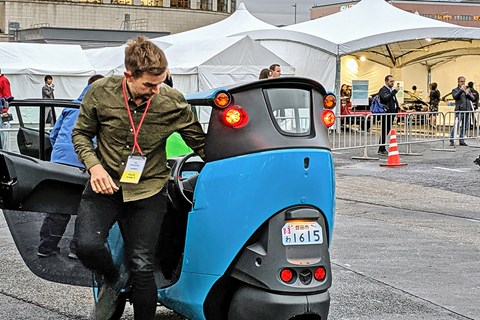► Toyota’s three-wheel jam buster
► Our test of dinky city slicker
► Does the i-Road actually work?
The idea of a vehicle combining the good bits of car (protection from the elements and crashing/being crashed into; intrinsic stability) and the good bits of a motorcycle (the ability to fly through traffic jams; fun; ease of parking; increased sexiness) is not new. BMW’s roofed scooter, the C1, was a slow-burn hit with commuters, and Renault’s battery-electric Twizy, while four-wheeled, riffs on the same idea.
The i-Road debuted way back at the 2013 Geneva motor show, but Toyota’s quest to morph from car maker to mobility provider has put some momentum behind the innovative three-wheeler, which has so far only been available via public trials (in Tokyo and Geneva).
It’s an intriguing package. There are two front wheels, each driven by an electric motor, and one rear wheel, which pivots to steer the i-Road from the rear at lower speeds. (Walking-speed steering does feel odd, but is only really used for manoeuvring.) Go quicker and the Toyota leans in corners, so it’s stable changing direction at speed despite its super-slim 90cm overall width.
Dubbed Active Lean Technology, the system is driven by a third (much smaller) electric motor and controlled by an ECU monitoring steering angle, speed and, via a gyroscope, lean angle. The control electronics can raise and lower the front wheels independently via the motor, a gearset and a yoke integrated into the front suspension.
The leaning system is entirely automatic – the only control is a car-style steering wheel, which should feel bizarre in a vehicle that leans but, impressively, doesn’t. What’s more, the i-Road’s Active Lean system, inspired by downhill skiers’ legs, works to keep the vehicle upright when traversing gradients or while navigating heavily cambered surfaces. The system also means you don’t need to stick your foot out when you stop, which in turn means the i-Road’s tandem two-seat cabin can be entirely weatherproof. You even get standard-issue car stuff like mirrors, a windscreen wiper, a seatbelt and simple buttons for reverse and drive; from there two pedals take care of going faster and slowing down, no gears.
Performance is modest (37mph top whack), as is the range (also 37 miles) of the Toyota’s lithium-ion battery, which can be recharged in three hours.

How it works
Fully charged
A zero-emission vehicle that doesn’t get stuck in traffic – what could be greener? Still, the 37-mile range won’t suit range-anxious worriers.
Feel at home!
Toyota doesn’t make motorcycles, and has instead made the i-Road feel like half a Smart ForTwo; steering wheel, seatbelts, actual seats.
Hop out, feel smug
You’re not late or stressed, as you would be had you come by car, and you’re not wet and/or injured, which you might have been on a bike…

Toyota i-Road: does it work?
Yes, brilliantly. The integration and calibration of the steering and lean system is superb – within moments you’re carving through traffic and around corners like you’ve been riding for years. Start to get carried away and tactile force-feedback through the steering wheel suggests you desist. And while it’s hardly luxurious, the i-Road feels like an S-Class compared to a conventional scooter.
Check out more CAR tech news